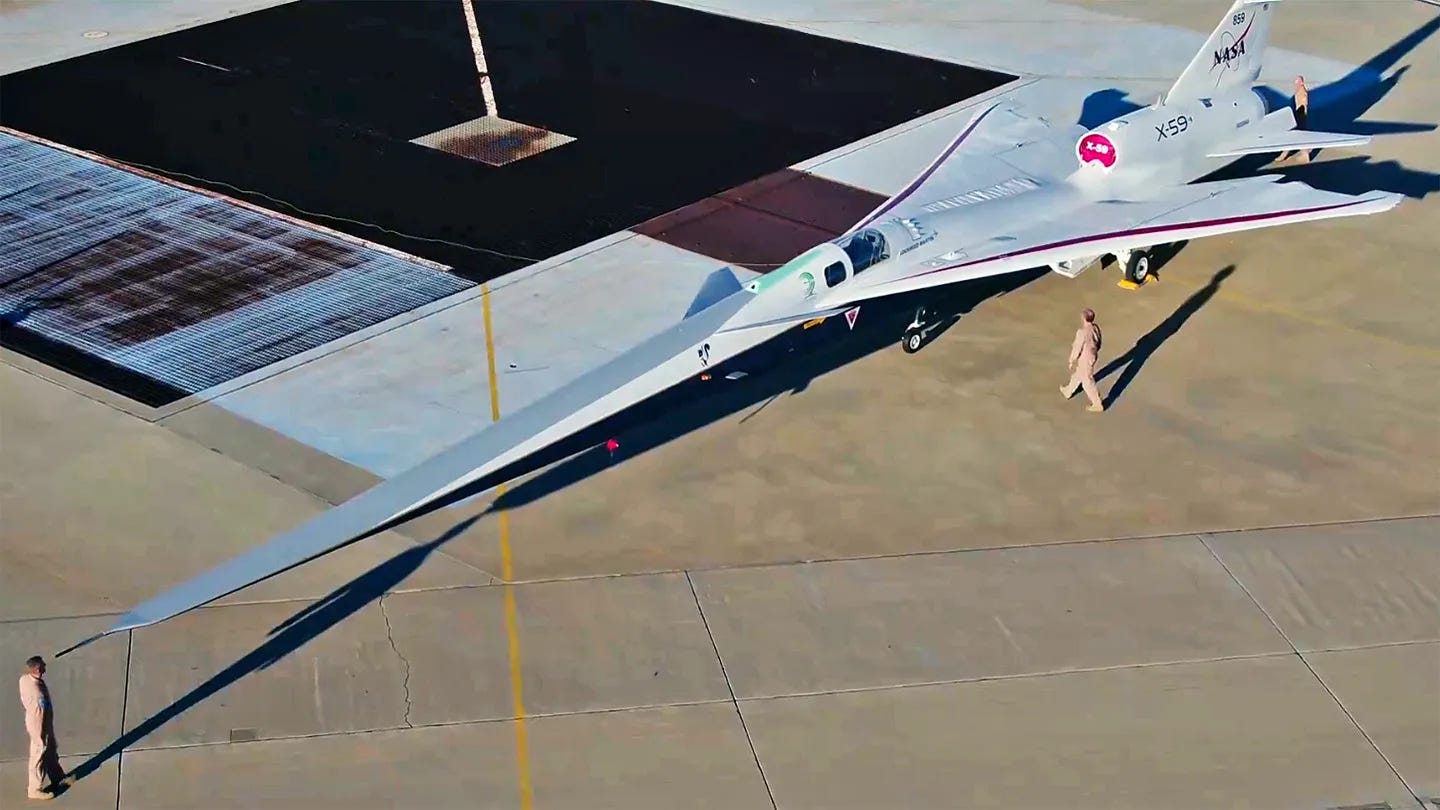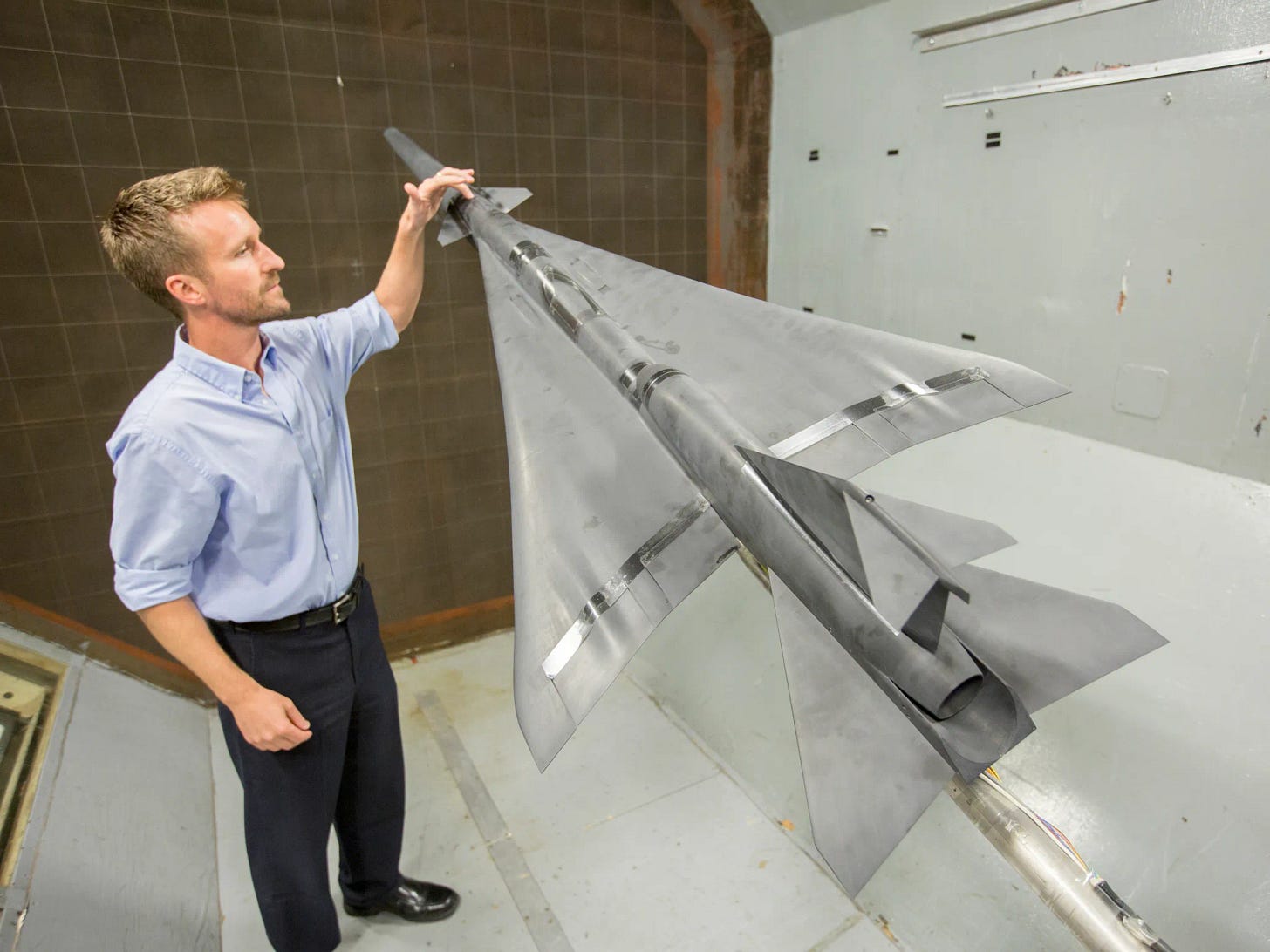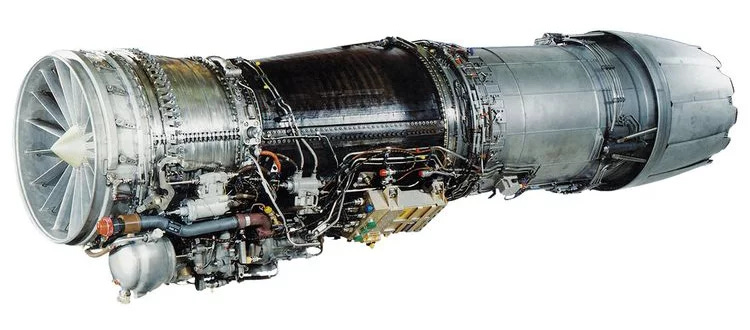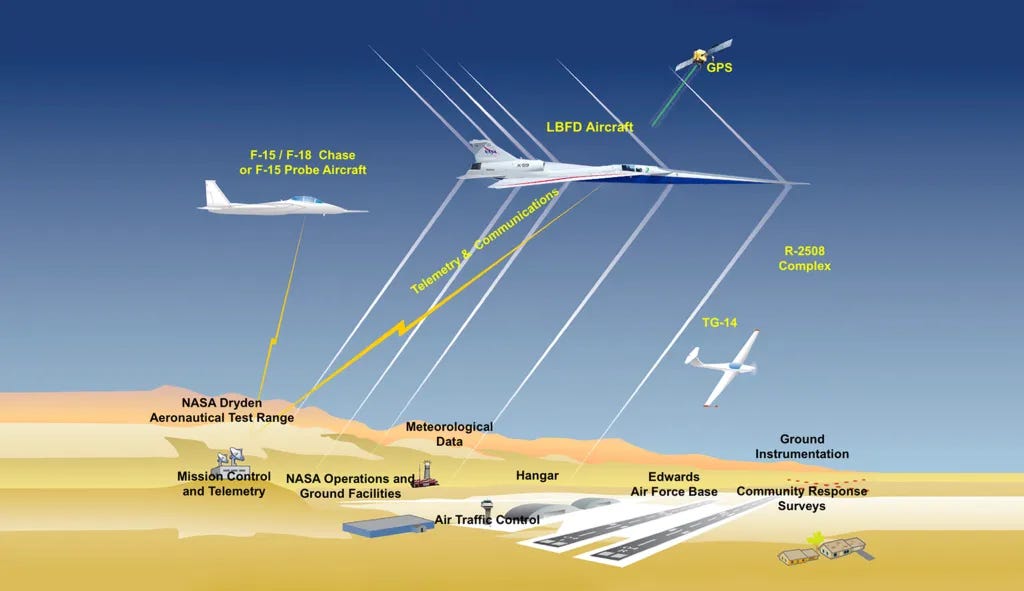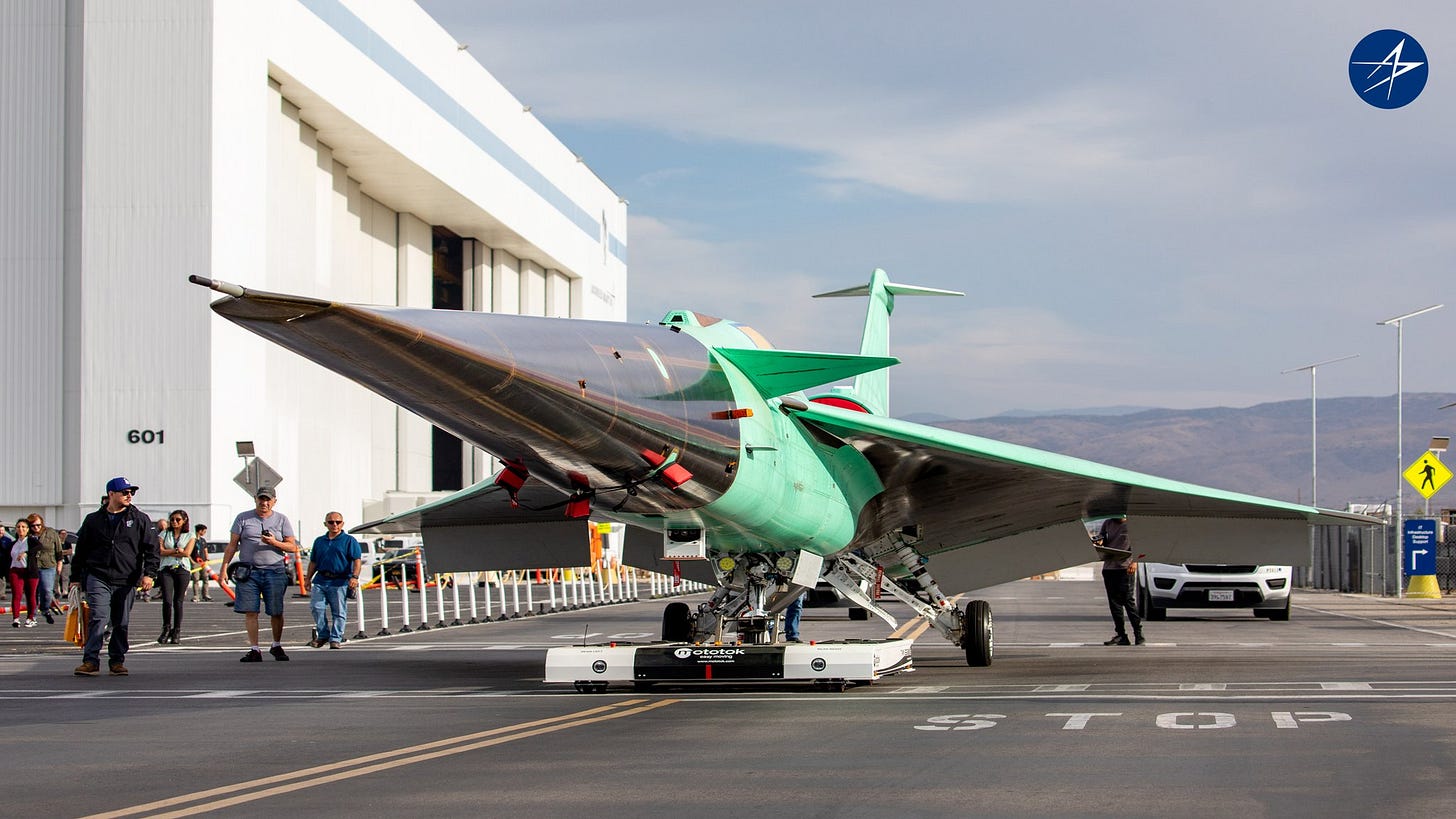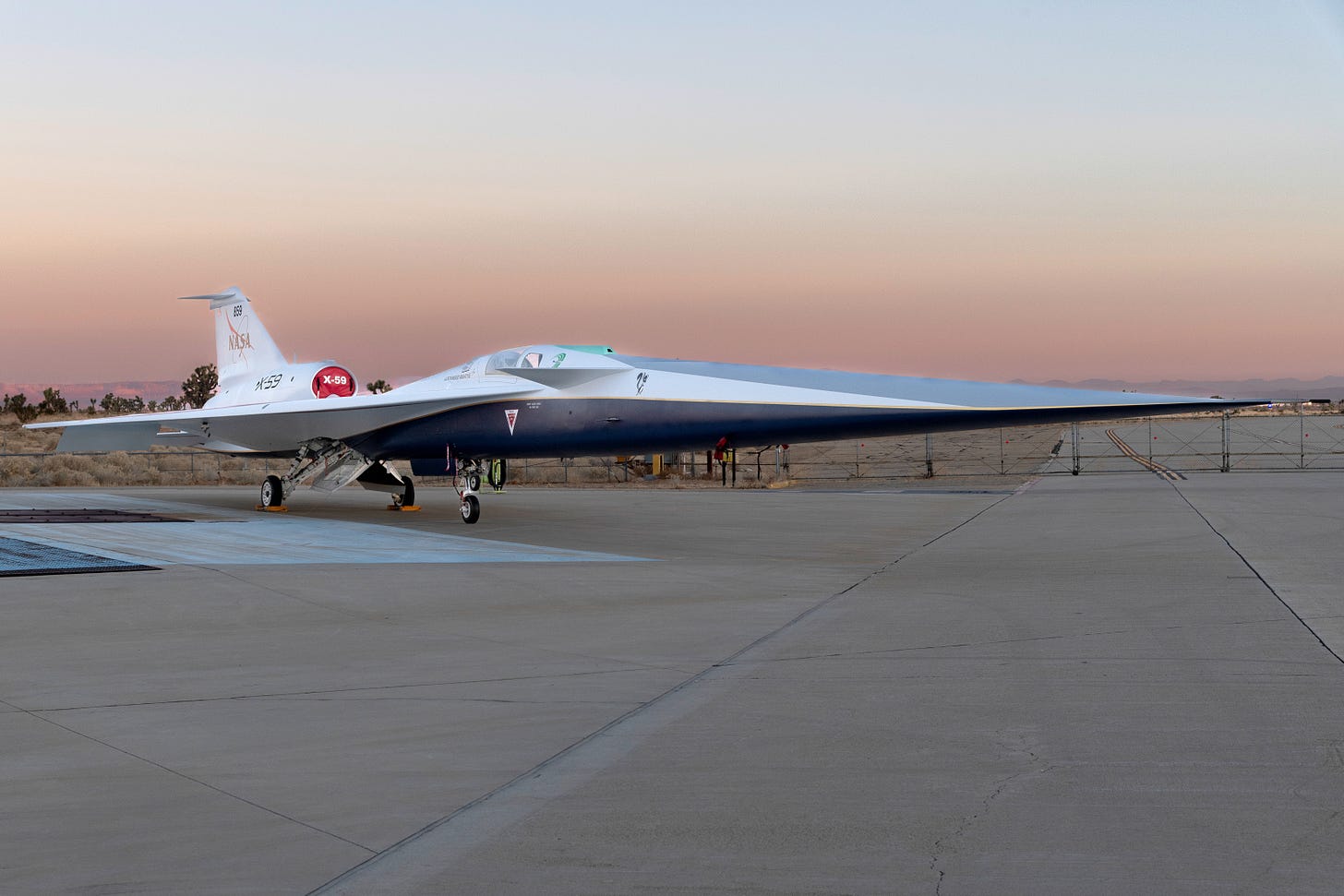NASA Is Testing This Supersonic Aircraft to Eliminate Sonic Booms
In this edition of The Engineer's Perspective.
The Engineer's Perspective is a reader-supported publication. Sign and up and subscribe to see more in-depth Aerospace/Aeronautical Analysis!
Table of Contents:
Overview
Historical Development
Specifications
Concept of Operations
Systems Engineering Requirements
Calculations (Optional)
Implications and Future Considerations
Conclusion
References
Introduction
The Lockheed Martin X-59 Quesst (Quiet SuperSonic Technology) is an experimental supersonic aircraft developed in collaboration with NASA to revolutionize air travel. This innovative project aims to demonstrate the feasibility of supersonic flight over land without producing disruptive sonic booms, addressing a longstanding barrier to commercial supersonic transport. The X-59's significance lies in its potential to enable faster-than-sound travel while mitigating the noise pollution traditionally associated with supersonic flight, potentially paving the way for a new era of high-speed commercial aviation.
Development of the X-59 began in 2016 when Lockheed Martin was awarded the preliminary design contract. The project has since progressed through various milestones, including wind tunnel testing, critical design reviews, and the commencement of assembly. In January 2024, the X-59 was unveiled to the public, marking a significant step forward. The aircraft incorporates innovative design features, such as a long, thin nose for shock wave mitigation, a modified F414 engine, and an external vision system for pilots in lieu of a traditional windshield.
Currently, the X-59 is undergoing final ground tests, with its first flight scheduled for early 2025. If successful, the X-59 could have far-reaching implications for both commercial and military aerospace sectors. In the commercial realm, it could lead to the lifting of bans on overland supersonic flights, potentially reducing travel times dramatically and opening new possibilities for global transportation. For the military, the technology developed for the X-59 could contribute to the advancement of quieter, more efficient supersonic aircraft, potentially enhancing operational capabilities while reducing acoustic signatures.
Overview
The X-59 Quesst is designed to fly at supersonic speeds while producing a significantly quieter sonic boom, referred to as a "sonic thump." This aircraft's primary objective is to gather data that could lead to new commercial supersonic flight standards, potentially enabling faster-than-sound travel over land. The project's significance lies in its potential to dramatically reduce air travel times while mitigating the noise pollution traditionally associated with supersonic flight.
Recent developments for the X-59 include its public unveiling on January 12, 2024, at Lockheed Martin's Skunk Works facility in Palmdale, California. This milestone marks a crucial step towards the aircraft's first flight, initially scheduled for later in 2024. Additionally, in November 2024, the X-59 team successfully conducted the first integrated engine tests, validating the aircraft's systems under its own power.
Historical Development
The journey of the X-59 began in February 2016 when Lockheed Martin was awarded a preliminary contract to design the aircraft. Since then, the project has progressed through several key milestones:
Wind tunnel testing of scale models: These tests were conducted at various facilities, including NASA Glenn's 8-foot by 6-foot supersonic wind tunnel and JAXA's 1m x 1m supersonic wind tunnel. The tests provided crucial data on the aircraft's aerodynamics and sonic boom characteristics.
Successful critical design review: Completed in September 2024, this milestone demonstrated that the X-59's design was mature enough to proceed with final assembly. The review assessed design maturity, build-to documentation, and remaining risks.
Commencement of assembly process: Following the critical design review, the X-59 began to take shape on the production floor at Lockheed Martin's Skunk Works facility.
December 2020: Construction reached the halfway point, marking significant progress in the aircraft's physical development.
2021 onwards: Flight-clearance testing at NASA's Armstrong Flight Research Center began, involving various ground tests and system checks to prepare the aircraft for its first flight.
January 2024: Public unveiling of the completed aircraft at Lockheed Martin's Skunk Works facility in Palmdale, California, showcasing the X-59's unique design features to the world.
October 2024: First integrated engine tests were successfully conducted, validating the aircraft's systems under its own power. This included running the F414-GE-100 engine with maximum afterburner, demonstrating its ability to operate within temperature limits and with adequate airflow for flight.
Specifications
The X-59 Quesst boasts several unique features and capabilities:
Speed: Expected to fly at Mach 1.4, which is approximately 925 mph (1,488 km/h) at cruising altitude. This speed allows the aircraft to achieve its supersonic flight goals while maintaining its noise reduction capabilities.
Length: 99.7 feet (30.4 meters), with an elongated nose section comprising nearly one-third of the total length.
Wingspan: 29.5 feet (9 meters), relatively narrow to optimize supersonic performance.
Maximum takeoff weight: 32,300 pounds (14,650 kg).
Propulsion: Single General Electric F414-GE-100 engine.
Thrust: 22,000 pounds (97.9 kN) with afterburner.
Length: 13 feet (3.96 meters).
Position: Mounted on top of the aircraft to reduce noise impact.
Operational altitude: Up to 55,000 feet (16,764 meters).
Unique design features:
Long, thin nose (38 feet or 11.6 meters) for shock wave mitigation.
No forward-facing cockpit window to maintain the aircraft's sleek profile.
eXternal Vision System (XVS) for pilot visibility, consisting of high-resolution cameras feeding a 4K monitor in the cockpit.
Smooth underside to prevent shockwaves from merging behind the aircraft.
Modified engine inlet adapted from the U-2 spy plane.
Noise reduction: Designed to produce a "sonic thump" instead of a sonic boom, with the goal of reducing the noise level to about 75 perceived decibels, similar to a car door closing.
These specifications and design features work in concert to enable the X-59 to achieve supersonic flight with significantly reduced noise, potentially revolutionizing commercial air travel and aerospace technology.
Concept of Operations
The X-59's operational framework is designed to demonstrate quiet supersonic flight and gather data for future commercial applications:
Stakeholders: NASA, Lockheed Martin, aerospace industry, regulatory agencies
Purpose: To collect data on community response to quiet supersonic flight over populated areas
Operational Overview:
Pre-Flight Operations:
Comprehensive system checks and flight planning
Integration of the eXternal Vision System
Flight Operations:
Takeoff and acceleration to supersonic speeds
Data collection on sonic boom characteristics
Community response surveys in overflown areas
Post-Flight Operations:
Data analysis and system performance evaluation
Aircraft inspection and maintenance
Key Capabilities:
Supersonic flight with reduced sonic boom intensity
Advanced aerodynamic design for shock wave control
Innovative pilot visibility system for safe operation
Systems Engineering Requirements
Based on the available information, the following expanded systems engineering requirements can be inferred for the X-59:
Performance Requirements
Speed:
The system shall achieve a minimum cruising speed of Mach 1.4 (925 mph)
The system shall maintain supersonic speed while producing reduced sonic boom intensity
Operational Altitude:
The system shall operate at cruising altitudes of approximately 55,000 feet
The system shall be capable of reaching altitudes up to 65,000 feet
Temperature Range:
The system shall operate in temperatures ranging from -0°F to 130°F
Structural Requirements
Dimensions:
The system shall have a length of 99.7 feet (30.4 meters)
The system shall have a wingspan of 29.5 feet (9 meters)
Weight:
The system shall have a maximum takeoff weight of 32,300 pounds (14,650 kg)
Design Features:
The system shall incorporate a long, thin nose (38 feet or 11.6 meters) for shock wave mitigation
The system shall have a smooth underside to prevent shockwaves from merging behind the aircraft
Propulsion Requirements
Engine:
The system shall utilize a single General Electric F414-GE-100 engine
The engine shall produce 22,000 pounds (97.9 kN) of thrust with afterburner
Engine Placement:
The engine shall be mounted on top of the aircraft to reduce noise impact
Avionics and Control Requirements
Vision System:
The system shall utilize the eXternal Vision System (XVS) for pilot visibility
The XVS shall consist of high-resolution cameras feeding a 4K monitor in the cockpit
Flight Control:
The system shall incorporate flight control systems capable of managing supersonic flight
Noise Reduction Requirements
Sonic Boom Mitigation:
The system shall produce a sonic thump significantly quieter than traditional sonic booms
The system shall aim to reduce the noise level to about 75 perceived decibels
Data Collection Requirements
Instrumentation:
The system shall incorporate sensors and instrumentation to collect data on sonic boom characteristics
The system shall be capable of near-field and mid-field shock wave measurements
Environmental Requirements
The system shall be designed to minimize environmental impact, considering factors such as fuel efficiency and emissions
Regulatory Compliance
The system shall be designed to meet or exceed all relevant aviation safety standards and regulations
These expanded requirements reflect the X-59's unique design features and mission objectives, encompassing its performance capabilities, structural design, and innovative technologies for quiet supersonic flight.
Implications and Future Considerations
The success of the X-59 could have far-reaching implications for both commercial and military aerospace sectors:
Commercial Aviation
The potential lifting of bans on overland supersonic flights could revolutionize air travel:
Dramatically reduced travel times, with flights from New York to London potentially taking as little as three hours.
New possibilities for global transportation, opening up routes previously impractical for supersonic travel.
Increased business opportunities and economic growth due to faster international travel.
Development of a new market for supersonic commercial aircraft, stimulating aerospace industry innovation and job creation.
Military Applications
Advancements in quiet supersonic technology could significantly impact military aviation:
Development of more efficient and stealthy supersonic aircraft, enhancing operational capabilities.
Improved reconnaissance and strike capabilities due to reduced acoustic signatures.
Potential adaptation of X-59's aerodynamic design for next-generation fighter jets and bombers, optimizing high-speed performance and maneuverability.
Enhanced ability to conduct rapid, high-speed missions with reduced detectability.
Regulatory Changes
Data from the X-59 could reshape aviation regulations:
Informing new noise standards for supersonic flight, potentially leading to the revision of current prohibitions on overland supersonic travel.
Collaboration with regulatory bodies like the FAA and international aviation authorities to establish new guidelines for commercial supersonic operations.
Potential creation of new air traffic control procedures and airspace management strategies to accommodate supersonic flights.
Environmental Impact
The project could contribute to more sustainable air travel:
Development of more fuel-efficient supersonic engines and aerodynamic designs, potentially reducing the carbon footprint of long-distance flights.
Advancements in materials and manufacturing processes for supersonic aircraft, leading to lighter and more environmentally friendly designs.
Potential reduction in overall emissions due to shorter flight times, despite higher fuel consumption at supersonic speeds.
Technological Advancements
The X-59 project is driving innovation in various aerospace technologies:
Advancements in shock wave mitigation and control, applicable to various high-speed vehicle designs.
Improvements in external vision systems and pilot interfaces for high-speed flight.
Development of new simulation and testing methodologies for supersonic aircraft design.
Economic Impact
Successful implementation of quiet supersonic technology could have significant economic implications:
Creation of a new market for supersonic business jets and commercial airliners.
Potential boost to tourism and international business due to reduced travel times.
Increased competitiveness in the global aerospace industry for countries and companies at the forefront of supersonic technology.
The X-59's success could mark the beginning of a new era in aviation, balancing the desire for faster travel with environmental and community concerns, while pushing the boundaries of aerospace technology in both civilian and military sectors.
Conclusion
The X-59 Quesst represents a groundbreaking advancement in aerospace technology, poised to revolutionize supersonic travel. By addressing the longstanding issue of sonic booms, this experimental aircraft could pave the way for a new era of high-speed commercial aviation. The project's success has the potential to dramatically reduce travel times, open new global transportation routes, and stimulate innovation across the aerospace industry.
Beyond its commercial implications, the X-59's technology could significantly impact military aviation, enhancing operational capabilities and stealth. The project is also driving advancements in various aerospace technologies, from shock wave mitigation to external vision systems for pilots.
As the X-59 progresses towards its first flight, it stands at the forefront of balancing the desire for faster travel with environmental and community concerns. If successful, this NASA-Lockheed Martin collaboration could reshape aviation regulations, contribute to more sustainable air travel, and usher in a new age of supersonic flight that benefits both civilian and military sectors.
References:
Here is the refined list with hyperlinks:
Comprehensive Analysis: General Electric F414 and F404 Engines
NASA Runs X-59 Engine with Maximum Afterburner for the First Time




